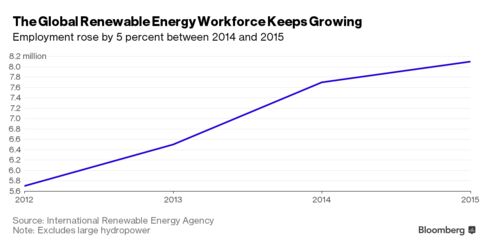Clean-Energy Jobs Surpass Oil Drilling for First Time in U.S.
By
Anna Hirtenstein
May 25, 2016 — 7:00 AM PDT
Green workforce rose 5% worldwide in 2015 to 8.1 million
Irena expects as many as 24 million in clean energy by 2030
The number of U.S. jobs in solar energy overtook those in oil and natural gas extraction for the first time last year, helping drive a global surge in employment in the clean-energy business as fossil-fuel companies faltered.
Employment in the U.S. solar business grew 12 times faster than overall job creation, the International Renewable Energy Agency said in a report on Wednesday. About 8.1 million people worldwide had jobs in the clean energy in 2015, up from 7.7 million in 2014, according to the industry group based in Abu Dhabi.

Fed by state initiatives to spur clean energy and innovative financing measures offered by companies such as SolarCity Corp., developers are adding workers at record rates to install rooftop panels. Oil and gas producers by contrast have slashed 351,410 jobs worldwide since prices began to slide in the middle of 2014, according to Houston-based Graves & Co.
“The continued job growth in the renewable energy sector is significant because it stands in contrast to trends across the energy sector,” said Adnan Amin, director-general of Irena, which is based in Abu Dhabi. “This increase is being driven by declining renewable energy technology costs and enabling policy frameworks. We expect this to continue as the case for renewables strengthens and countries move to achieve climate targets.”

The pace of jobs growth worldwide slowed last year from 18 percent in 2014 mainly because of lower investment in biofuels following the oil price slump, which made alternative fuels less economically attractive, Irena said. Brent crude prices slipped 35 percent last year, the third consecutive decline. Biofuels made from crops such as sugar and corn employed 1.7 million workers, second to solar with almost 2.8 million jobs.
The group projects the workforce in clean energy will grow to 24 million by 2030 if United Nations targets are met on climate change and development.
The 58 percent slide in oil prices since June 2014, triggered by Saudi Arabia’s grab for market share, has prompted reductions in employment in the fossil-fuels industry. Many higher-cost producers in the U.S. shale industry, Canada’s oil sands and Brazil’s deepwater-drilling projects have become unprofitable. The transition to clean energy spurred by a landmark deal in Paris involving almost 200 nations is reflected in the global labor market for renewables.

China installed the most new renewable capacity in the world in 2015 with 65 gigawatts. It employed 35 percent more people in its clean energy industry than in oil and gas.

China, Brazil and the U.S. were at the front of the pack for renewable energy jobs. Asia is home to 60 percent of the world’s renewable energy employees, up from just over 50 percent in 2013. Japan saw jobs in its solar PV industry gain by 28 percent in 2014.

Most of Brazil’s clean energy workers were in the liquid biofuels industry, which was the second-largest job market in renewables after solar PV.
bloomberg.com |









